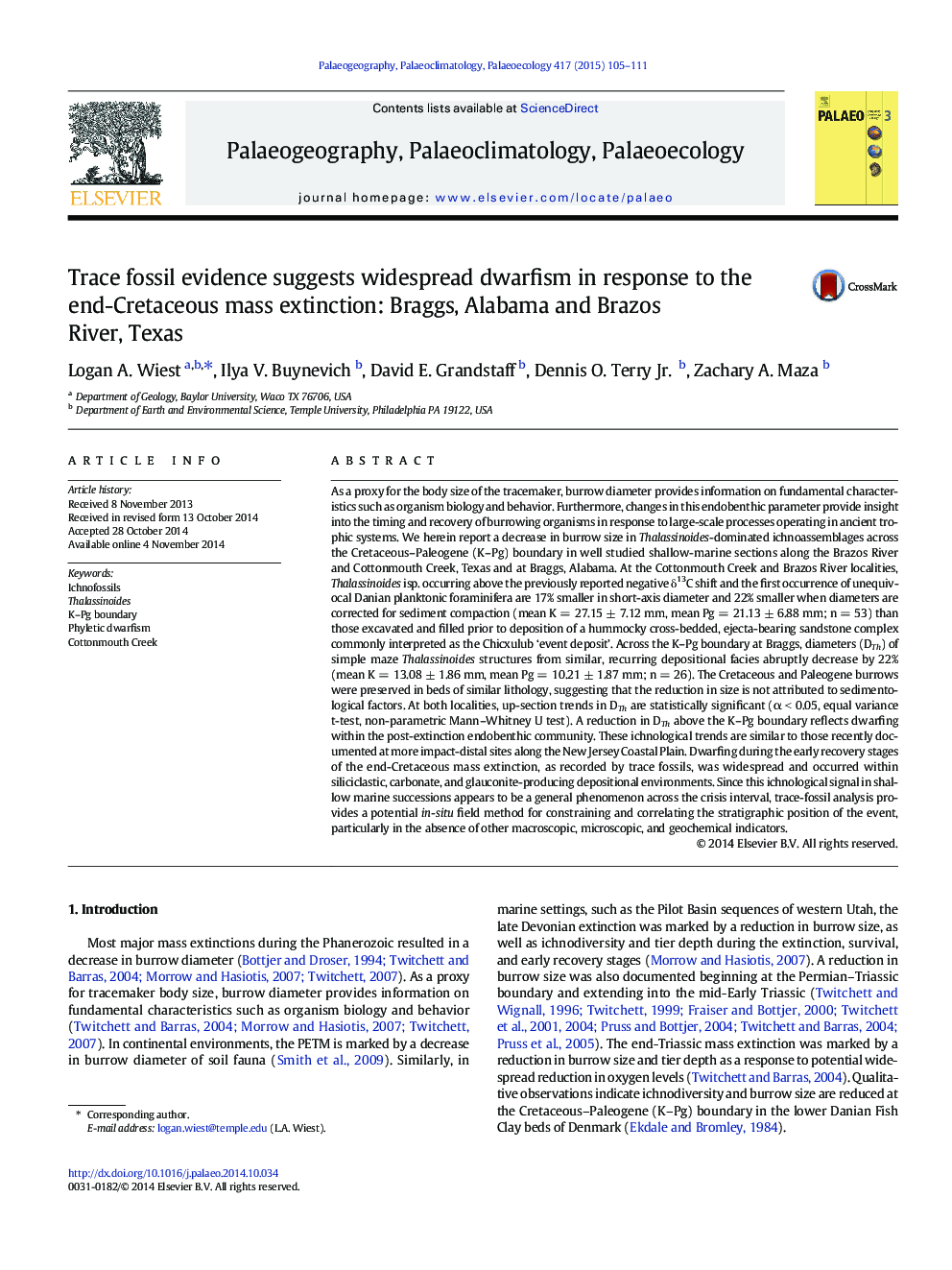| کد مقاله | کد نشریه | سال انتشار | مقاله انگلیسی | نسخه تمام متن |
|---|---|---|---|---|
| 6349846 | 1622173 | 2015 | 7 صفحه PDF | دانلود رایگان |
عنوان انگلیسی مقاله ISI
Trace fossil evidence suggests widespread dwarfism in response to the end-Cretaceous mass extinction: Braggs, Alabama and Brazos River, Texas
ترجمه فارسی عنوان
ردیابی شواهد فسیلی نشان می دهد که کوتوله های گسترده ای در واکنش به انقراض جمعی آخر کرتاسه بروگس، آلاباما و رودخانه برازو، تگزاس
دانلود مقاله + سفارش ترجمه
دانلود مقاله ISI انگلیسی
رایگان برای ایرانیان
موضوعات مرتبط
مهندسی و علوم پایه
علوم زمین و سیارات
فرآیندهای سطح زمین
چکیده انگلیسی
As a proxy for the body size of the tracemaker, burrow diameter provides information on fundamental characteristics such as organism biology and behavior. Furthermore, changes in this endobenthic parameter provide insight into the timing and recovery of burrowing organisms in response to large-scale processes operating in ancient trophic systems. We herein report a decrease in burrow size in Thalassinoides-dominated ichnoassemblages across the Cretaceous-Paleogene (K-Pg) boundary in well studied shallow-marine sections along the Brazos River and Cottonmouth Creek, Texas and at Braggs, Alabama. At the Cottonmouth Creek and Brazos River localities, Thalassinoides isp. occurring above the previously reported negative δ13C shift and the first occurrence of unequivocal Danian planktonic foraminifera are 17% smaller in short-axis diameter and 22% smaller when diameters are corrected for sediment compaction (mean K = 27.15 ± 7.12 mm, mean Pg = 21.13 ± 6.88 mm; n = 53) than those excavated and filled prior to deposition of a hummocky cross-bedded, ejecta-bearing sandstone complex commonly interpreted as the Chicxulub 'event deposit'. Across the K-Pg boundary at Braggs, diameters (DTh) of simple maze Thalassinoides structures from similar, recurring depositional facies abruptly decrease by 22% (mean K = 13.08 ± 1.86 mm, mean Pg = 10.21 ± 1.87 mm; n = 26). The Cretaceous and Paleogene burrows were preserved in beds of similar lithology, suggesting that the reduction in size is not attributed to sedimentological factors. At both localities, up-section trends in DTh are statistically significant (α < 0.05, equal variance t-test, non-parametric Mann-Whitney U test). A reduction in DTh above the K-Pg boundary reflects dwarfing within the post-extinction endobenthic community. These ichnological trends are similar to those recently documented at more impact-distal sites along the New Jersey Coastal Plain. Dwarfing during the early recovery stages of the end-Cretaceous mass extinction, as recorded by trace fossils, was widespread and occurred within siliciclastic, carbonate, and glauconite-producing depositional environments. Since this ichnological signal in shallow marine successions appears to be a general phenomenon across the crisis interval, trace-fossil analysis provides a potential in-situ field method for constraining and correlating the stratigraphic position of the event, particularly in the absence of other macroscopic, microscopic, and geochemical indicators.
ناشر
Database: Elsevier - ScienceDirect (ساینس دایرکت)
Journal: Palaeogeography, Palaeoclimatology, Palaeoecology - Volume 417, 1 January 2015, Pages 105-111
Journal: Palaeogeography, Palaeoclimatology, Palaeoecology - Volume 417, 1 January 2015, Pages 105-111
نویسندگان
Logan A. Wiest, Ilya V. Buynevich, David E. Grandstaff, Dennis O. Jr., Zachary A. Maza,
